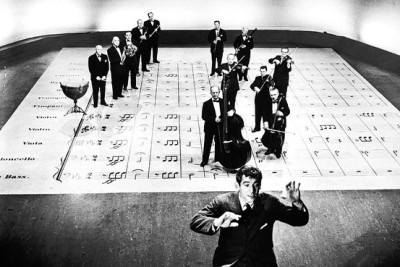- 5 September – Gustav Mahler Dressed to the Nines – Hev you heard of the "Curse"? A short discussion on the curse and Mahlerès late symphonies, with a cover-to-cover performance of the Mahler Ninth by Kurt Sanderling and the (East-) Berlin Symphony. http://itywltmt.blogspot.com/2014/09/gustav-mahler-dressed-to-nines.html
- 12 September – Antonin Dvorak Dressed to the Nines – is the "New World" Symphony American music, or not? We explore the question, and discover a cover-to-cover copy of a mid-90's recording of Dvorak works (including his ninth) by Paavo Jarvi and the Royal Philharmonic. http://itywltmt.blogspot.com/2014/09/antonin-dvorak-dressed-to-nines.html
- 19 September – Anton Bruckner Dressed to the Nines – Karajan an the Berlin Philharmonic provide a performance of the unfinished Bruckner Ninth, completed by a performance of his Te Deum. Read how this is how Brickner saw the two pieces working together. http://itywltmt.blogspot.com/2014/09/anton-bruckner-dressed-to-nines.html
- 26 September – Franz Schubert Dressed to the Nines – Riccardo Muti and the Vienna Phulharmonic tackle Schubert's "Great C Major" symphony, and selections from Rosamunde. http://itywltmt.blogspot.com/2014/09/franz-schubert-dressed-to-nines.html
- 2 September - Pierre’s Podcast Vault Selection of the Month. Our montage from March 2012 features "birds". The montage is presented on our Pod-O-Matic Channel until September 30. http://www.talkclassical.com/blogs/itywltmt/1699-empty-nest.html
- 9 September – Vinyl's Revenge is a new momthly feature on the Tuesday Blog and our YouTube Channel, exploring old LPès from my collection, This month, a 1984 CBC Records release featuring l’Orchestre des Jeunes du Québec playing Gli Uccelli (The bBirds) by Respighi and Schubert's Third. http://www.talkclassical.com/blogs/itywltmt/1700-vinyls-revenge-lorchestre-des.html
- 16 September – La Chronique du Disque (Summer 2014) – A bonus Tuesday gives us an opportunity to look at some of my acquisitions during the Summer break Among them, works by Vaughan Williams and Honegger. http://www.talkclassical.com/blogs/itywltmt/1706-la-chronique-du-disque.html
- 23 September – Once Upon the Internet – Slovenian clarinettist Jozé Kotar, in tracks downloaded off MP3.COM. http://www.talkclassical.com/blogs/itywltmt/1720-clarinetist-jo-e-kotar.html
- 30 September – La Chronique du Disque – Our "regular" edition, featuring recent acquisitions. Among them, tracks by Carlo Bergonzi and James Ehnes. http://www.talkclassical.com/blogs/itywltmt/1722-la-chronique-du-disque.html
Once or Twice a Fortnight




